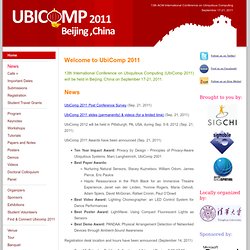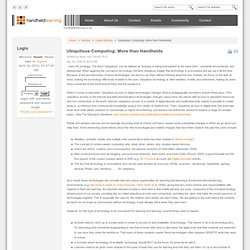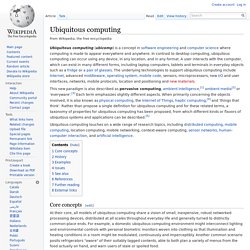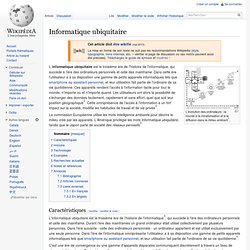

FingerTIP. Pervasive computing.
Centre de Recherche en informatique ubiquitaire en France. Www.percom.org. 13th ACM International Conference on Ubiquitous Computing. Welcome to UbiComp 2011.

AwareIT: Internet of Things & Smart Objects. eBiquity Blog. At the ISWC Privon workshop in October, Neel Guha talked about his Spy Watch Google Chrome extension that keeps track of the third parties tracking the web pages you visit.

Unlike Ghostery, it only collects information and can not block tracking sites, but it logs more information about how your Web behavior is being observed and gives good insight into the nature and scope of the Web tracking phenomenon. When you view a page like www.nytimes.com you expect it to know that you visited the site. It may even know personal information (e.g., name, address, age, sex) if ever divulged it to the site, perhaps when setting up an account. Spy Watch reports that my recent visit to the NYT site was also observed by 24 other sites, including doubleclick.com, brightcove.com, googleapis.com and sothebysrealty.com.
And this is with an ad blocker enabled — 28 third parties observed me when I disable it. Each of these third parties also knows the page on the NYT site I just visited. IPerG - Integrated Project of Pervasive Games. Participate Online. Personal and Ubiquitous Computing. CUbiC - The Center for Cognitive Ubiquitous Computing. Handheld Learning - Ubiquitous Computing: More than Handhelds. The word "ubiquitous" can be defined as "existing or being everywhere at the same time”, constantly encountered, and widespread.

When applying this concept to technology, the term ubiquitous implies that technology is everywhere and we use it all the time. Because of the pervasiveness of these technologies, we tend to use them without thinking about the tool. Instead, we focus on the task at hand, making the technology effectively invisible to the user. Ubiquitous technology is often wireless, mobile, and networked, making its users more connected to the world around them and the people in it. When it comes to education, Ubiquitous access to digital technologies changes what is pedagogically possible in at least three ways. Mobile and wireless devices are increasingly becoming tools of choice, and have caused some substantial changes in which we go about our daily lives. MAYA Design. UbiMob'09. Ubiquitous computing.
Ubiquitous computing (ubicomp) is a concept in software engineering and computer science where computing is made to appear everywhere and anywhere.

In contrast to desktop computing, ubiquitous computing can occur using any device, in any location, and in any format. A user interacts with the computer, which can exist in many different forms, including laptop computers, tablets and terminals in everyday objects such as a fridge or a pair of glasses. Human-centered computing (discipline) Human-centered computing (HCC) is a broadly defined interdisciplinary buzzword concerned with computing and computational artifacts as they relate to the human condition.

Researchers and practitioners who affiliate themselves with human-centered computing usually come from one or more of the following disciplines: human factors, computer science, sociology, psychology, cognitive science, anthropology, communication studies, graphic design, science and technology studies, and industrial design. The term "human-centered computing" originates from Rob Kling and Susan Leigh Star in the paper "Human Centered Systems in the Perspective of Organizational and Social Informatics".[1] According to Kling and Star, the key feature of human-centered computing systems is that "knowledge of human users and the social context in which systems are expected to operate become integrated into the computer science agenda, even at the earliest stages of research and development. " Career[edit] References[edit] Domotique. Réalité virtuelle. Intelligence ambiante. Un article de Wikipédia, l'encyclopédie libre.

L'évolution des ordinateurs : la course à la miniaturisation et à la diffusion dans le milieu ambiant L'intelligence ambiante est ce que pourrait devenir l'informatique dans la première moitié du XXIe siècle en repoussant les limites technologiques qu'elle avait à la fin du XXe siècle [réf. nécessaire]. Ce concept semble pouvoir tenir lieu de traduction non littérale aux concepts nés en Amérique du Nord sous le vocable initial d'informatique ubiquitaire, systèmes pervasifs ou encore ordinateur évanescent [réf. nécessaire]. Wearable computer. The WIMM One, an Android powered wearable computer.

Wearable computers, also known as body-borne computers or wearables are miniature electronic devices that are worn by the bearer under, with or on top of clothing.[1] This class of wearable technology has been developed for general or special purpose information technologies and media development. Wearable computers are especially useful for applications that require more complex computational support than just hardware coded logics.
If one is asked to give a simple, yet modern, example for wearable technology, that will be the Nike+ system which allows you to track your time, distance, pace and calories via a sensor in the shoe. Another example can be Google Glass, which combine innovative displays with some novel gestural movements for interaction. One of the main features of a wearable computer is consistency. Areas of applications[edit] Wearable computer items have been initially developed for and applied with e.g. History[edit] Sentient computing. Sentient computing is a form of ubiquitous computing which uses sensors to perceive its environment and react accordingly.

A common use of the sensors is to construct a world model which allows location-aware or context-aware applications to be constructed. One famous research prototype of a sentient computing system was the work at AT&T Laboratories, Cambridge (now defunct). It consisted of an ultrasonic indoor location system called the "Active Bats" which provided a location accuracy of about 3 cm.
The world model was managed via the SPIRIT database, using CORBA to access information and spatial indexing to deliver high-level events such as "Alice has entered the kitchen" to listening context-aware applications. The research continues at the Digital Technology Group at the University of Cambridge. Some example applications of the system include: Ubiquitous Computing Consortium - Home. Personal and Ubiquitous Computing.
Informatique ubiquitaire. Un article de Wikipédia, l'encyclopédie libre.

L'évolution des ordinateurs : la course à la minaturisation et à la diffusion dans le milieu ambiant[1]. L´informatique ubiquitaire est la troisième ère de l'histoire de l'informatique, qui succède à l'ère des ordinateurs personnels et celle des mainframe. Dans cette ère l'utilisateur a à sa disposition une gamme de petits appareils informatiques tels que smartphone ou assistant personnel, et leur utilisation fait partie de l'ordinaire de sa vie quotidienne.